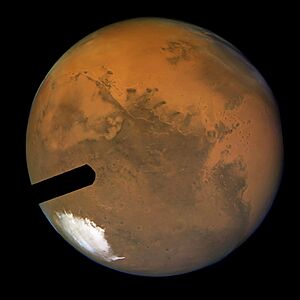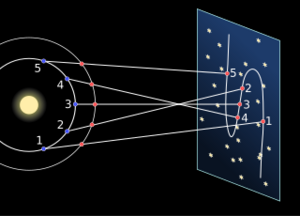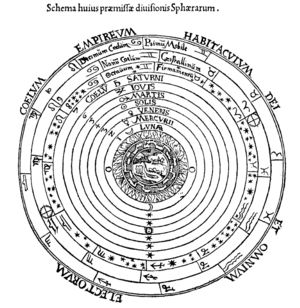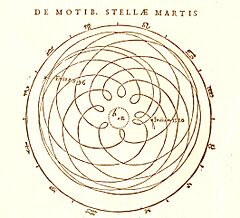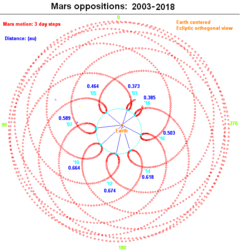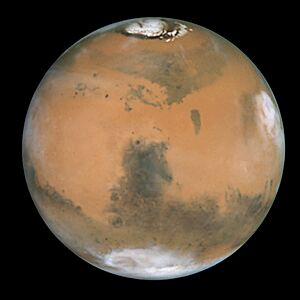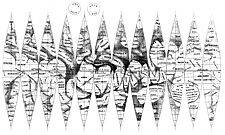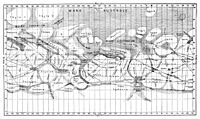History of Mars observation facts for kids
The history of Mars observation is all about how people have watched and studied the planet Mars over thousands of years. Some of the earliest records of Mars come from ancient Egyptian astronomers way back in the 2nd millennium BCE. Chinese records about Mars' movements appeared even before the Zhou dynasty (1045 BCE).
Babylonian astronomers made very detailed notes about Mars. They even created math methods to guess where the planet would be in the future. Ancient Greek thinkers and astronomers believed in a geocentric model. This meant they thought Earth was the center of the Solar System, and Mars moved around it. Old Greek and Indian writings also mention how big Mars looked in the sky.
In the 1500s, Nicolaus Copernicus suggested a new idea: the Sun was the center of our solar system. He said planets, including Mars, orbited the Sun in circles. Later, Johannes Kepler improved this idea. He found that Mars actually moves in an oval path, which fit the observations much better.
The first time someone looked at Mars through a telescope was in 1610, by Galileo Galilei. Within 100 years, astronomers found clear features on Mars. These included dark patches like Syrtis Major Planum and bright polar ice caps. They also figured out how long it takes Mars to spin (its rotation period) and how much it tilts (its axial tilt). These discoveries were mostly made when Mars was closest to Earth, a time called opposition.
Better telescopes in the 1800s helped map Mars in great detail. The first rough map came out in 1840. More accurate maps followed from 1877 onwards. For a while, people thought they saw signs of water in Mars' atmosphere. This made the idea of life on Mars very popular. Percival Lowell even thought he saw a network of artificial canals on Mars. But these lines turned out to be an optical illusion, and Mars' atmosphere was too thin for an Earth-like environment.
Since the 1870s, scientists have seen yellow clouds on Mars. Eugène M. Antoniadi thought these were sand or dust blown by wind. In the 1920s, Mars' surface temperature was measured. It ranged from −85 to 7 °C (−121 to 45 °F). The atmosphere was found to be very dry, with only tiny amounts of oxygen and water. In 1947, Gerard Kuiper showed that Mars' thin atmosphere had a lot of carbon dioxide. This was about twice the amount found in Earth's atmosphere.
In 1960, the International Astronomical Union (IAU) created the first official names for features on Mars. Since the 1960s, many robotic spacecraft have been sent to explore Mars. They have orbited the planet and landed on its surface. Scientists also keep watching Mars from Earth and space using different tools that see various parts of the electromagnetic spectrum. We've even found meteorites on Earth that came from Mars. This lets us study the planet's chemistry in labs.
Contents
Early Views of Mars
Ancient Egyptian astronomers were the first to record Mars as a "wandering star." By 2000 BCE, they knew about the apparent retrograde motion of Mars. This is when the planet seems to move backward in the sky before continuing its normal path. Mars was even drawn on the ceilings of ancient tombs, like the one for Seti I. The oldest known star map, from 1534 BCE, also shows Mars.
By the time of the Neo-Babylonian Empire, Babylonian astronomers regularly watched the planets. They knew, for example, that Mars completed 37 cycles (called synodic periods) every 79 years. The Babylonians used math to make small corrections to their predictions of Mars' position. They mostly used timing measurements, like when Mars rose, instead of its exact spot in the sky.
Chinese records of Mars go back before the Zhou dynasty (1045 BCE). By the Qin dynasty (221 BCE), astronomers kept careful notes of planets lining up, including Mars. They even saw Venus pass in front of Mars in 368, 375, and 405 CE. During the Tang dynasty (618 CE), they knew a lot about Mars' orbit and movement.
Early Greek astronomy was influenced by ideas from Mesopotamia. The Babylonians linked Mars to Nergal, their god of war. The Greeks then connected Mars to their own god of war, Ares. At first, the Greeks weren't very interested in how planets moved.
How We Understood Mars' Orbit
The Greeks called planets planēton, meaning "wanderers." They believed these seven objects moved around a central Earth. The Greek philosopher Plato wrote about the order of the planets. He listed them from closest to furthest from Earth: Moon, Sun, Venus, Mercury, Mars, Jupiter, Saturn, and then the fixed stars. Plato thought that objects further away moved slower.
Aristotle, one of Plato's students, saw the Moon pass in front of Mars on May 4, 357 BCE. This made him realize that Mars must be further away than the Moon. He used this to support the Greek idea of the planets' order. Aristotle's model showed the Sun, Moon, and planets circling Earth at fixed distances. A more complex model was created by Hipparchus. He suggested that Mars moved on a small circle (an epicycle) that, in turn, moved along a larger circle (a deferent) around Earth.
In the 100s CE, Claudius Ptolemaeus (Ptolemy) in Roman Egypt tried to solve the problem of Mars' orbit. Observations showed Mars moved 40% faster on one side of its orbit. This didn't fit Aristotle's idea of steady motion. Ptolemy added a special point (an equant) that was offset from the center of the orbit. He said Mars moved at a steady speed around this point. Ptolemy's model and his astronomy work were written in his book, Almagest. This book was the main source for Western astronomy for the next 1,400 years.
In the 400s CE, the Indian astronomical book Surya Siddhanta estimated Mars' size. They said it was 2 arc-minutes (1/30 of a degree) across. They also estimated its distance from Earth. From this, they calculated Mars' diameter to be about 6,070 km (3,772 miles). This is only about 11% off the real value of 6,788 km (4,218 miles). However, this estimate was based on a guess of Mars' size, and it might have been influenced by Ptolemy's work. Both estimates were much larger than what telescopes later showed.
In 1543, Nicolaus Copernicus published his idea of a Sun-centered (heliocentric) solar system. In his book De revolutionibus orbium coelestium, he placed Earth orbiting the Sun between Venus and Mars. His model successfully explained why Mars, Jupiter, and Saturn appeared on the opposite side of the sky from the Sun when they were moving backward. Copernicus could figure out the correct order of the planets just by how long they took to orbit the Sun. His idea slowly became accepted in Europe.
On October 13, 1590, German astronomer Michael Maestlin saw Venus pass in front of Mars. One of his students, Johannes Kepler, quickly believed in Copernicus's system. Kepler later worked for the astronomer Tycho Brahe. Kepler used Tycho's detailed observations of Mars. He tried to fit Mars' motion into a circular orbit, but it didn't work. Finally, he found that if Mars' orbit was an ellipse (an oval) with the Sun at one focus, it matched Tycho's observations perfectly. This discovery led to Kepler's laws of planetary motion. He published these laws in his book Epitome Astronomiae Copernicanae between 1615 and 1621.
Early Telescope Views
When Mars is closest, it looks very small, only 25 arcseconds across. This is too tiny for the naked eye to see any details. So, before telescopes, people only knew Mars was red and where it was in the sky. The Italian scientist Galileo Galilei was the first to use a telescope for astronomy. He started watching Mars in September 1610. His telescope wasn't powerful enough to see surface details. He wanted to see if Mars had phases, like Venus or the Moon. He wasn't sure if he succeeded, but by December, he noticed Mars looked smaller. Polish astronomer Johannes Hevelius clearly saw a phase of Mars in 1645.
In 1644, Italian Jesuit Daniello Bartoli reported seeing two dark patches on Mars. During Mars' closest approaches to Earth in 1651, 1653, and 1655, Italian astronomer Giovanni Battista Riccioli and his student Francesco Maria Grimaldi saw patches of different brightness on Mars. The first person to draw a map of Mars showing features was Dutch astronomer Christiaan Huygens. On November 28, 1659, he drew Mars showing the dark region now called Syrtis Major Planum. He also likely drew one of the polar ice caps. That same year, he measured Mars' rotation period to be about 24 hours. He also guessed Mars' diameter was about 60% of Earth's, which is very close to the real value of 53%.
The first clear mention of Mars' southern polar ice cap was by Italian astronomer Giovanni Domenico Cassini in 1666. That same year, he used surface markings to find Mars' rotation period: 24 hours and 40 minutes. This is less than three minutes different from today's accepted value. In 1672, Huygens saw a fuzzy white cap at Mars' north pole.
After Cassini became the first director of the Paris Observatory in 1671, he worked on figuring out the true size of the Solar System. The relative sizes of planet orbits were known from Kepler's third law. But they needed to know the actual size of one orbit. So, they measured Mars' position against background stars from different places on Earth. This helped them find the planet's diurnal parallax. In 1672, Mars was very close to Earth. Cassini and Jean Picard measured Mars from Paris, while Jean Richer measured it from Cayenne, South America. Even with imperfect tools, Cassini's parallax calculation was within 10% of the correct value. English astronomer John Flamsteed tried similar measurements with similar results.
In 1704, Italian astronomer Jacques Philippe Maraldi studied the southern ice cap. He saw that it changed as Mars rotated, meaning it wasn't perfectly centered on the pole. He also noticed the cap's size changed over time. German-born British astronomer Sir William Herschel started observing Mars in 1777, focusing on its polar caps. In 1781, he saw the south cap was "extremely large." He thought this was because that pole had been in darkness for a year. By 1784, the southern cap was much smaller. This suggested the caps change with Mars' seasons, meaning they are made of ice. In 1781, he estimated Mars' rotation period as 24 hours, 39 minutes, and 21.67 seconds. He also measured the axial tilt of Mars' poles to be 28.5 degrees. He believed Mars had a "considerable but moderate atmosphere," suggesting its inhabitants might live in conditions similar to Earth's. Between 1796 and 1809, French astronomer Honoré Flaugergues saw Mars getting blurry. He thought "ochre-colored veils" covered the surface. This might be the first report of yellow clouds or dust storms on Mars.
Mapping Mars' Surface
In the early 1800s, telescopes got much better. German optician Joseph von Fraunhofer created a new type of lens that made images clearer. By 1812, he made a lens 190 mm (7.5 in) wide. The size of this main lens is key for how much light a telescope can gather and how clear its images are. In 1830, German astronomers Johann Heinrich Mädler and Wilhelm Beer used a 95 mm (3.7 in) Fraunhofer telescope to study Mars. They picked a feature south of the equator as a reference point. This spot was later named the Sinus Meridiani and became the zero meridian of Mars. They found that most of Mars' surface features were permanent. They also figured out Mars' rotation period more accurately. In 1840, Mädler used ten years of observations to draw the first map of Mars. Instead of names, Beer and Mädler used letters for features.
Working at the Vatican Observatory in 1858, Italian astronomer Angelo Secchi saw a large blue triangle on Mars, which he called the "Blue Scorpion." English astronomer J. Norman Lockyer saw this same cloud-like shape in 1862. During the 1862 opposition, Dutch astronomer Frederik Kaiser drew Mars. By comparing his drawings to older ones, he made Mars' rotation period even more precise: 24 hours, 37 minutes, and 22.6 seconds. This is accurate to within a tenth of a second!
Father Secchi made some of the first color drawings of Mars in 1863. He named features after famous explorers. In 1869, he saw two dark lines on the surface. He called them canali, which is Italian for 'channels' or 'grooves'. In 1867, English astronomer Richard A. Proctor made a more detailed map of Mars. He named features after astronomers who had studied Mars. Other similar maps were made by French astronomer Camille Flammarion and English astronomer Nathan Green.
At the University of Leipzig in 1862–64, German astronomer Johann K. F. Zöllner created a special tool to measure how much light the Moon, planets, and stars reflected. For Mars, he found it reflected 27% of the light. Between 1877 and 1893, German astronomers Gustav Müller and Paul Kempf used Zöllner's tool. They found that Mars' surface was smooth, without big bumps. In 1867, French astronomer Pierre Janssen and British astronomer William Huggins used spectroscopes to study Mars' atmosphere. They compared Mars' light to the Moon's. Since the Moon's light didn't show water, they thought they found water vapor in Mars' atmosphere. This was confirmed by others but later questioned. In 1882, an article in Scientific American talked about snow on Mars' poles and wondered about ocean currents.
In 1877, Mars was very close to Earth. English astronomer David Gill used this chance to measure Mars' parallax from Ascension Island. This helped him figure out the Earth's distance from the Sun more accurately. He noticed Mars' edge looked fuzzy because of its atmosphere, which made it harder to pinpoint its exact position.
In August 1877, American astronomer Asaph Hall discovered the two moons of Mars using a 660 mm (26 in) telescope. He named them Phobos and Deimos, based on a suggestion from Henry Madan.
The "Martian Canals" Idea
During Mars' close approach in 1877, Italian astronomer Giovanni Schiaparelli used a 22 cm (8.7 in) telescope to make the first detailed map of Mars. These maps famously showed features he called canali. These were later proven to be an optical illusion. These canali were supposedly long, straight lines on Mars' surface, which he named after famous rivers on Earth. His word canali was wrongly translated in English as "canals." In 1886, English astronomer William F. Denning noticed these lines were not straight and had breaks. By 1895, English astronomer Edward Maunder was convinced that the lines were just many smaller details put together.
In his 1892 book, La planète Mars et ses conditions d'habitabilité, Camille Flammarion wrote that these channels looked like man-made canals. He thought an intelligent race might use them to move water across a dying Mars. He believed such beings existed and might be more advanced than humans.
Inspired by Schiaparelli, Percival Lowell built an observatory with 30-and-45 cm (12-and-18 in) telescopes. He used them to study Mars during its close approaches. He published books about Mars and life there, which greatly influenced the public. Other astronomers, like Henri Joseph Perrotin and Louis Thollon, also saw the canali using a large telescope in France.
Starting in 1901, American astronomer A. E. Douglass tried to photograph the canal features. These efforts seemed to work when American astronomer Carl O. Lampland published photos of the supposed canals in 1905. Many people accepted these results. However, Greek astronomer Eugène M. Antoniadi and English naturalist Alfred Russel Wallace argued that they were just imagined features. As bigger telescopes were used, fewer long, straight canali were seen. In 1909, Flammarion used a large 84 cm (33 in) telescope. He saw irregular patterns, but no canali.
Starting in 1909, Eugène Antoniadi helped disprove the Martian canali theory. He used the huge 83 cm (33 in) telescope at Meudon. Mars was at its closest, and the weather was very clear. The canali disappeared before Antoniadi's eyes. They turned into various "spots and blotches" on the surface of Mars.
Learning More About Mars

Yellow clouds that hid the surface had been seen since the 1870s by Schiaparelli. More evidence for these clouds appeared in 1892 and 1907. In 1909, Antoniadi noticed that yellow clouds appeared when surface features were hidden. He found that Mars looked yellower when it was closest to the Sun and got more energy. He thought the clouds were caused by windblown sand or dust.
In 1894, American astronomer William W. Campbell found that Mars' light spectrum was the same as the Moon's. This made people doubt that Mars' atmosphere was like Earth's. Earlier claims of water on Mars were explained by bad viewing conditions. Campbell believed the water signals came from Earth's atmosphere. He agreed that the ice caps meant there was some water, but not enough to be easily detected in the atmosphere. At the time, Campbell's findings were debated, but American astronomer Walter S. Adams confirmed them in 1925.
German astronomer Hermann Struve used changes in the orbits of Mars' moons to figure out the planet's shape. In 1895, he estimated that Mars' diameter at the equator was 1/190 larger than at the poles. In 1911, he refined this to 1/192. American meteorologist Edgar W. Woolard confirmed this in 1944.
In 1924, American astronomers Seth Barnes Nicholson and Edison Pettit measured the heat coming from Mars' surface. They found temperatures ranged from −68 °C (−90 °F) at the pole to 7 °C (45 °F) at the equator. In the same year, radiated energy measurements were made by American physicist William Coblentz and American astronomer Carl Otto Lampland. They showed that Mars' night temperature dropped to −85 °C (−121 °F). This meant huge temperature swings between day and night. Martian clouds were measured at −30 °C (−22 °F). In 1926, American astronomer Walter Sydney Adams measured the oxygen and water vapor in Mars' atmosphere. He found that "extreme desert conditions" were common on Mars. In 1934, Adams and American astronomer Theodore Dunham Jr. found that Mars' atmosphere had less than one percent of the oxygen found over a similar area on Earth.
In 1927, Dutch student Cyprianus Annius van den Bosch calculated Mars' mass using its moons' movements. His result was very accurate. This was confirmed by Dutch astronomer Willem de Sitter in 1938.
In the 1920s, French astronomer Bernard Lyot used a special tool to study the surfaces of the Moon and planets. In 1929, he noted that the light from Mars' surface was very similar to the Moon's. He thought this could be explained by frost or even plants. He also estimated that Mars' atmosphere was no more than 1/15 as thick as Earth's. This meant the surface pressure was very low. In 1947, Dutch-American astronomer Gerard Kuiper found carbon dioxide in Mars' atmosphere. He estimated that Mars had twice as much carbon dioxide as Earth. However, he thought Mars' surface pressure was higher than it was. So, he wrongly concluded that the ice caps couldn't be frozen carbon dioxide. In 1948, American meteorologist Seymour L. Hess figured out that Mars' thin clouds would only need a tiny amount of water.
The first official names for Mars' features were adopted by the International Astronomical Union (IAU) in 1960. They used 128 names from Antoniadi's 1929 map. In 1973, the IAU created a group to standardize names for Mars and other space bodies.
Modern Ways to Study Mars

The International Planetary Patrol Program started in 1969. This group worked together to constantly watch for changes on planets, especially dust storms on Mars. Their images helped scientists study Mars' seasonal patterns globally. They showed that most Martian dust storms happen when the planet is closest to the Sun.
Since the 1960s, robotic spacecraft have been sent to explore Mars in great detail. They have orbited the planet and landed on its surface. Also, scientists keep studying Mars from Earth and space using telescopes that see different parts of the electromagnetic spectrum. This includes infrared observations to find out what the surface is made of. They also use ultraviolet and submillimeter observations to study the atmosphere. Radio measurements help them find wind speeds.
The Hubble Space Telescope (HST) has taken the clearest images of Mars ever seen from Earth. This telescope can take good pictures of Mars when it's at least 50 degrees away from the Sun. Hubble can photograph an entire hemisphere of Mars, showing whole weather systems. Earth-based telescopes with special cameras can also take useful images of Mars. This allows scientists to regularly watch the planet's weather during its closest approaches.
In 2001, astronomers first saw X-rays coming from Mars using the Chandra X-ray Observatory. In 2003, they found these X-rays had two parts. One part comes from X-rays from the Sun bouncing off Mars' upper atmosphere. The second part comes from interactions between ions. The XMM-Newton orbiting observatory has seen these X-rays up to eight times Mars' radius.
In 1983, scientists studied a group of meteorites (called SNC meteorites). They found that these rocks might have come from Mars. The Allan Hills 84001 meteorite, found in Antarctica in 1984, is also thought to be from Mars. But it has a very different makeup than the SNC group. In 1996, it was announced that this meteorite might have signs of tiny fossils of Martian bacteria. However, this idea is still debated. Chemical tests on Martian meteorites found on Earth suggest that Mars' surface temperature has likely been below freezing (0 °C) for most of the last four billion years.
Recent Views of Mars
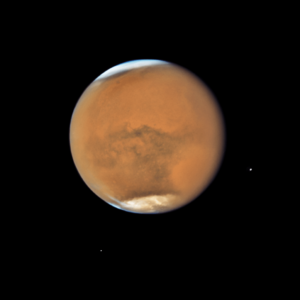
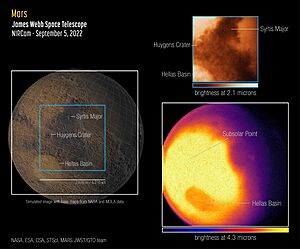
See also
 In Spanish: Historia de la observación de Marte para niños
In Spanish: Historia de la observación de Marte para niños
- Exploration of Mars
- Mars in history
- Mars lander


